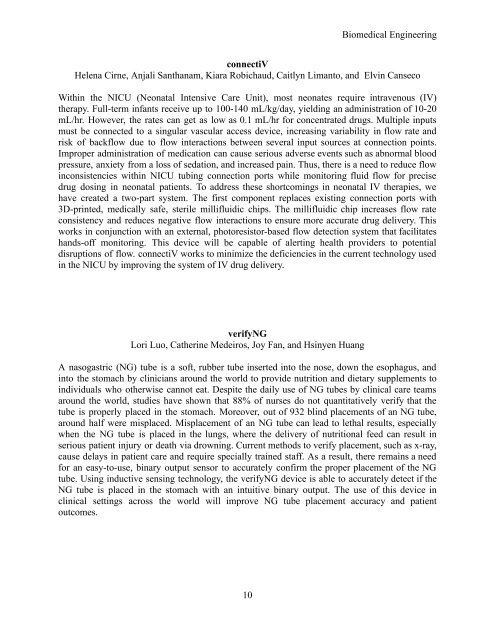Create successful ePaper yourself
Turn your PDF publications into a flip-book with our unique Google optimized e-Paper software.
Biomedical Engineering<br />
connectiV<br />
Helena Cirne, Anjali Santhanam, Kiara Robichaud, Caitlyn Limanto, and Elvin Canseco<br />
Within the NICU (Neonatal Intensive Care Unit), most neonates require intravenous (IV)<br />
therapy. Full-term infants receive up to 100-140 mL/kg/day, yielding an administration of 10-20<br />
mL/hr. However, the rates can get as low as 0.1 mL/hr for concentrated drugs. Multiple inputs<br />
must be connected to a singular vascular access device, increasing variability in flow rate and<br />
risk of backflow due to flow interactions between several input sources at connection points.<br />
Improper administration of medication can cause serious adverse events such as abnormal blood<br />
pressure, anxiety from a loss of sedation, and increased pain. Thus, there is a need to reduce flow<br />
inconsistencies within NICU tubing connection ports while monitoring fluid flow for precise<br />
drug dosing in neonatal patients. To address these shortcomings in neonatal IV therapies, we<br />
have created a two-part system. The first component replaces existing connection ports with<br />
3D-printed, medically safe, sterile millifluidic chips. The millifluidic chip increases flow rate<br />
consistency and reduces negative flow interactions to ensure more accurate drug delivery. This<br />
works in conjunction with an external, photoresistor-based flow detection system that facilitates<br />
hands-off monitoring. This device will be capable of alerting health providers to potential<br />
disruptions of flow. connectiV works to minimize the deficiencies in the current technology used<br />
in the NICU by improving the system of IV drug delivery.<br />
verifyNG<br />
Lori Luo, Catherine Medeiros, Joy Fan, and Hsinyen Huang<br />
A nasogastric (NG) tube is a soft, rubber tube inserted into the nose, down the esophagus, and<br />
into the stomach by clinicians around the world to provide nutrition and dietary supplements to<br />
individuals who otherwise cannot eat. Despite the daily use of NG tubes by clinical care teams<br />
around the world, studies have shown that 88% of nurses do not quantitatively verify that the<br />
tube is properly placed in the stomach. Moreover, out of 932 blind placements of an NG tube,<br />
around half were misplaced. Misplacement of an NG tube can lead to lethal results, especially<br />
when the NG tube is placed in the lungs, where the delivery of nutritional feed can result in<br />
serious patient injury or death via drowning. Current methods to verify placement, such as x-ray,<br />
cause delays in patient care and require specially trained staff. As a result, there remains a need<br />
for an easy-to-use, binary output sensor to accurately confirm the proper placement of the NG<br />
tube. Using inductive sensing technology, the verifyNG device is able to accurately detect if the<br />
NG tube is placed in the stomach with an intuitive binary output. The use of this device in<br />
clinical settings across the world will improve NG tube placement accuracy and patient<br />
outcomes.<br />
10








